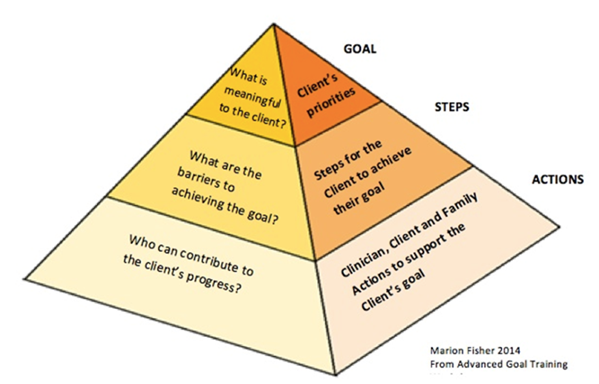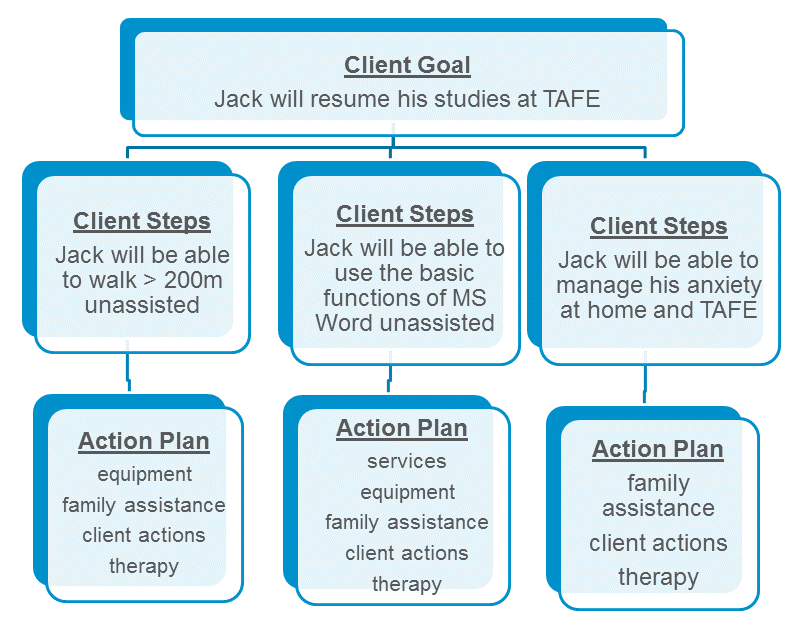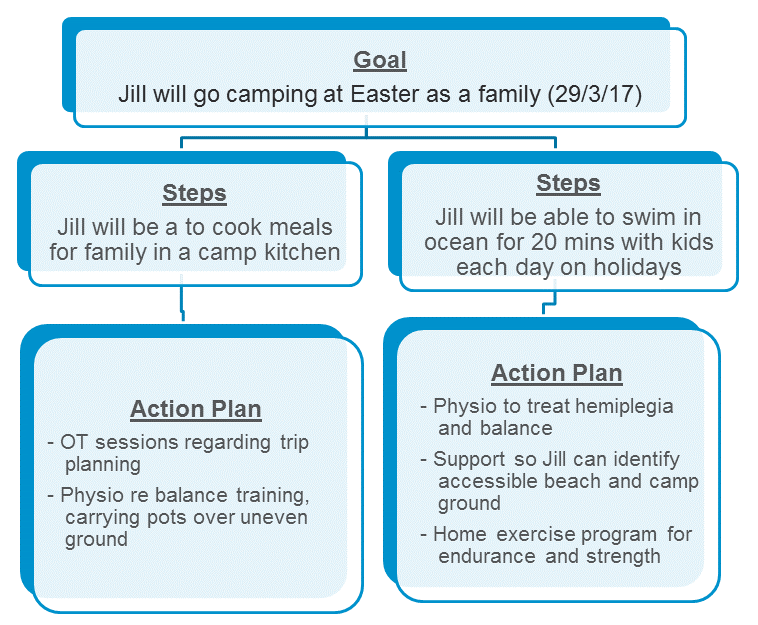- SELF STUDY MODULES
- 1. Intro to TBI
- 2. Communication
- 3. Skills for independence
- 4. Cognitive changes
- 5. Behaviour changes
- 6. Sexuality
- 7. Case management (BIR)
- 8. No longer available
- 9. Mobility & motor control
- 10. Mental health & TBI:
an introduction - 11. Mental health problems
and TBI: diagnosis
& management - 12. Working with Families
after Traumatic Injury:
An Introduction - 13. Goal setting
- 13.0 Aims
- 13.0A Take the PRE-Test
- PART A:
SETTING GOALS
IN REHABILITATION
- 13.A1 Goal setting in rehabilitation
- 13.A2 Goals, steps and action plans
- 13.A3 Goal setting in Person centred care
- 13.A4 Person centred/directed planning & goals
- 13.A5 Participation
focus & goals - 13.A6 Effective Goals
- 13.A7 SMARTAAR Goals: Characteristics
- 13.A8 Tips for Funders and Services
- 13.A9 Take home messages
- PART B: TEAMS &
GOALS - PART C: WORKSHEETS
- PART D:
POST-TEST
AND RESOUCES
13.A2 Goals, steps & action plans
- (i) Introduction:
Rehabilitation Plans - (ii) Goals
- (iii) Steps
- (iv) Action
plans - (v)
Example 1 - (vi)
Example 2
Introduction: Individual Service Plans & Rehabilitation Plans
Individual Service Plans and/or Rehabilitation Plans are frequently used in rehabilitation.
The format of the Individual Service Plans or Rehabilitation (rehab) plans varies according to individual services.
However, the information contained in a plan typically includes what in this Module we call:
- Goals,
- Steps and
- Action plans
Sometimes steps are called sub-goals or objectives.
Sometimes action plans are called strategies.

What terms do you use for the Rehabilitation Plan or Individual Service Plan? For goals, Steps and Action Plans?
What terms do you use in your service for goals, steps, action plans, etc?:
In this Module we use:
- Goals,
- Steps and
- Action plans
Im PART A SETTING GOALS IN REHABILITATION of this Module we use Individual Service Plan
In PART B IN CLINICAL SETTINGS we use the term Rehabilitation Plan
You may want to print this page for reference if the terms you use are different from Goals, Steps and Action Plans.
Goal
- ‘The object of one’s ambition or effort; a desired end or result’
- The intended outcome of a specific set of interventions .
The goal is what the person wants to achieve; it can also be seen as why the client is undertaking the rehabilitation program and why services are being provided and/or clinicians are providing interventions.
Later in the Module much more will be said about:
- What effective goals look like
- Criteria for assessing goals
- Criteria for the process of using goals
Steps
These are the activities / behaviours the client needs to be able to do to achieve their overarching goal.
Completing all of the steps will lead to the achievement of the overarching goal (assuming no unforeseen circumstances occur and no activities /behaviours have been omitted).
Whilst the use of a particular term for this facet of goal setting will be discipline specific (e.g. sub-goals, objectives), the concept remains the same. The term ‘step’ is used in this Module and this is relevant to what you may refer to as sub-goals or objectives.
Each goal will have a number of steps. Steps describe the behaviours/actions that together will enable the client to achieve their overarching goal.
Each step needs to describe one behaviour/activity only. This makes it easier to assess a client’s progress towards their goal. For example, in order to achieve a goal of resuming studies at TAFE, a client may need to improve their mobility, improve their computer literacy and be able to manage their anxiety in the local community and while at TAFE. Each of these activities is to be written as separate steps.
Action Plan
The action plan outlines the specific plans that describe how the client's goal will be achieved. In other words, those actions that need to be completed to achieve each of the steps. Each step may comprise a number of actions.
The action plan includes everything that is required to achieve the goal, such as accessing services, obtaining equipment and engaging family assistance, as well as actions for the person to undertake.
Whilst the use of a particular term for this facet of goal setting will be discipline specific (e.g. strategies), the underlying concept remains the same.
The term ‘action plan’ will be used in this Module.
Example 1

Example 2

